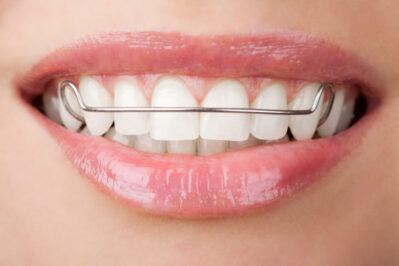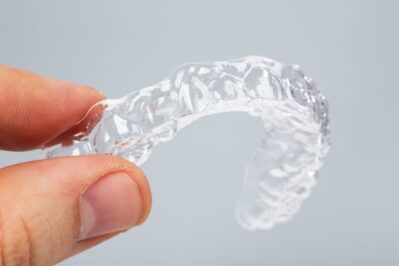How To Choose The Right Retainer
Finally getting your braces removed is a big deal; after all, you’ve been wearing them for a long time! Yet your journey doesn’t end there; your teeth have a great memory and if they’re not kept in their new place, they’ll go right back to where they were. A retainer is the best way to prevent that, but which one is best for you? Here’s some information to help you choose—but first:
Why Will Your Teeth Still Move After They’ve Been In Braces?
This is the most frequently asked question we get at our family orthodontics office. The answer is it’s not your teeth, but the ligaments attached to each one that move. In order for your teeth to remain in their new positions, their individual ligaments need to be long enough to keep them there.
However, ligaments need time to stretch. A lot of time. Your braces applied a lot of tension to your teeth and ligaments over several months. This level of tension is no longer required, but your ligaments need to be reminded of their new position for a while after your braces have been removed.
How Long Will You Need To Wear A Retainer?
The amount of time you’ll need to wear a retainer will depend on the severity of your orthodontic issue. Typically, orthodontic specialists will recommend wearing removable retainers 24 hours a day for the first three months or so. Other types of retainers may need to be worn for longer.
Types Of Retainers
There are retainers you can remove, and retainers that you can’t. Which type you end up with depends on the issue you initially needed braces for, as well as your personal preferences. Your orthodontist will suggest which type is best for your individual needs. After that, your choice will depend on:
- How durable you need your braces to be
- How much maintenance they need
- How they look
- How convenient they are for you to wear
The Removable Retainer
A removable retainer allows you to experience some freedom from orthodontic appliances. It also lets you see what your new smile looks like. Your orthodontist is likely to advise you to wear your removable retainer for as many hours as possible in the first few months after you get them. Removable retainers are available in two sub-types: Hawley and Essix. Both are made of clear plastic or acrylic material, but the Hawley is one of the oldest retainer types.
Hawley
Hawley retainers include bendable and visible wires that sit against the teeth. Loops placed near your long and pointed canine teeth allow your orthodontist to make adjustments over time. You may need only an upper or lower retainer, or you may need both; either way, molds need to be made of your teeth so that you get an exact fit.
This type of retainer will generally require about 16 to 18 hours of wear each day for the first couple of months. This will change as you go in for checkups and your orthodontist sees positive results in the position of your teeth.
The acrylic construction of the Hawley makes it easy to melt when exposed to high temperatures, as well as easy to break. Therefore, you’ll want to remove it before ingesting hot food or liquid and participating in any contact sports.
If the Hawley retainer does get broken, it might be able to be repaired. This retainer type will feel a bit bulky in the mouth, however. It will take some getting used to, so a little bit of patience will go a long way.
Essix
Essix retainers don’t contain any wires, making them virtually invisible. This can be a good choice if you don’t want anyone to know you’re wearing a retainer. Just like transparent braces, molds of your teeth have to be made for the Essix retainer, which slips right over your teeth and provides gentle tension for minor corrections in teeth alignment.
This type of retainer will need to be worn 24 hours a day until your first checkup or after eight weeks, whichever comes first. Because it is more delicate than other types of retainers, you’ll want to be careful of preventing cracking when removing the Essix before you eat or drink.
Essix retainers are also susceptible to damage from heat and impact. Additionally, they cannot be repaired once broken.
Cleaning, Care, and Maintenance
You’ll need to clean your retainer using a soft toothbrush with lukewarm water right after you take it out of your mouth. Adding mild dish soap will allow for a deeper clean, but you never want to use any kind of toothpaste to clean your retainer, as it will cause scratching.
Brush your teeth while your retainer is out of your mouth, and don’t forget to also clean your retainer’s case. Keep your retainer away from pets and children, as, to them, retainers make great chew toys! You’ll also want to ensure you always store your retainer in its case so you don’t lose it.
Permanent Retainers
Permanent or bonded retainers consist of a wire that fits along the new curve of your teeth. Cement is used to bond the wire to the teeth. These retainers remain on the teeth for several years, and they can only be removed by your orthodontist.
They may be recommended for you if your teeth have a high chance of returning to their old position or relapsing after your braces have been removed. They may also be an option if you are unlikely to remember to wear removable retainers. Because they’re installed behind your teeth, they are invisible. In addition, permanent retainers aren’t easily damaged and are impossible to lose or misplace.
Cleaning, Care, and Maintenance
Permanent retainers will require regular cleaning and flossing to preserve oral health and remove debris that becomes trapped under the cement and wires and between teeth. Even a good cleaning may not remove it all because so many areas are difficult to reach. Flossing after you brush can help with this; if regular floss is difficult to use, a threader can help.
There are also many water flossers on the market which can make it much easier to clean your teeth. They shoot water at high pressure, which can help to dislodge trapped debris from your retainer.
Just as with removable retainers, regular checkups with your orthodontist will be necessary so that they can inspect your retainer for loose wires and signs of damage and wear. Although you may not need to wear them for the rest of your life, a permanent retainer may need replacement after a number of years.
Whichever retainer type you choose, your orthodontist will provide you with detailed instructions and is happy to answer any other questions you may have.
The Best Ways To Ensure Retainer Success
When you first got your braces, you were likely warned about eating certain foods. The same is true when you wear any kind of retainer. Acid-forming foods can cause damage to your enamel when they become trapped beneath your removable or permanent retainer. Sticky foods can cause the cement in permanent retainers to loosen and the wires to bend.
We cannot stress enough how important it is to have regular orthodontist visits. They know when your retainer will need adjustment, repair, or replacement. After all, a retainer that isn’t doing its job will not help your teeth to stay in their new positions.
Finally, getting top-quality orthodontic care is an absolute must. It’s the only way to ensure complete success with your retainer for a new smile that will last for life. Labbe Family Orthodontics has the knowledge and experience to keep your smile healthy. We treat every patient like family and give you the information you need to make informed decisions about your orthodontic care.
Our complimentary orthodontic consultation is available at each of our Annapolis, Bowie, Crofton/Gambrills, and Greenbelt locations. Call (410) 267-7300 to book yours, and you’ll discover why, at Labbe, life is better with a smile.





